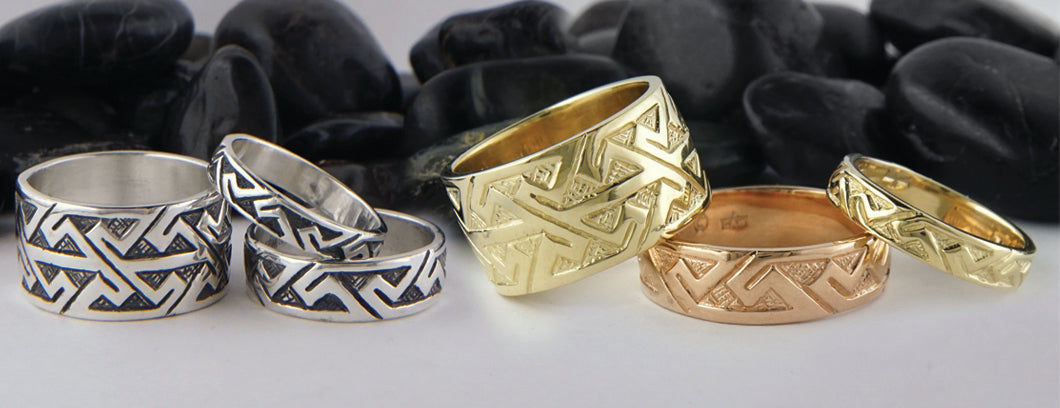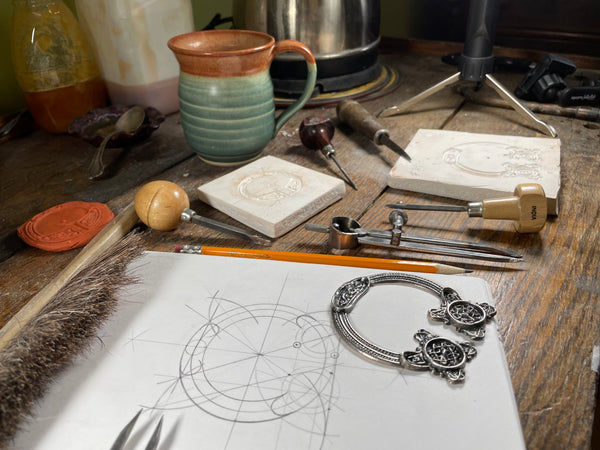
Pictish Key Pattern Rings in Gold and Silver by Walker Metalsmiths
My great-grandfather, John Walker, was born in Scotland quite near a splendid specimen of Pictish stone sculpture in Chapel of Garioch, Aberdeenshire. The Maiden Stone is a ten-foot-high, three-foot-wide pillar of red granite carved with a ringed “Celtic” cross on one side and five panels of symbols on the reverse. One of the irregular edges is incised with a pattern of knotwork and the other is a meandering path of another type of Celtic ornament known as key pattern.

The Maiden Stone, 8th or 9th century. Chapel of Garioch, Aberdeenshire, Scotland. Photo by Ruth Black
John Walker, who emigrated to the United States as an adult, was the son of James and Margaret Walker. James was an employee of the Great North of Scotland Railway. At the time of John’s birth in 1865 James would have been working from the Pitcaple railway station, a mere two miles from this excellent example of Pictish art. James was born in nearby Rhynie, another site that has yielded a great deal of Pictish art. He is buried in Fyvie, only a few yards from a group of Pictish stones built into the wall of St. Peter’s Church. I would like to think this stuff is in my blood.
The Picts were a medieval society that inhabited northeast Scotland in the 3rd to 10th centuries. Their mysterious history has been difficult for scholars to understand due to a lack of surviving written records, but the Picts have left an enormous record carved in stone. The style of their monuments puts them firmly in the greater Celtic culture, showing artistic themes closely kin to the sculpture, metalwork, and manuscript art of the contemporary Irish.

Key patterns have also been described as maze or labyrinth designs. The similarity to Greek “fret” patterns is often noted. These angular, straight sided spirals bear similarity to the ornaments of many cultural traditions around the world, however the style and conventions of Celtic or Insular key patterns allow for great variation and creative complexity.
For reasons we can only speculate about, key patterns were generally overlooked during the 19th century Celtic Revival. Key patterns appear in such classic Celtic art treasures as the Book of Kells and the Ardagh Chalice, however they are relatively rare in modern manifestations of the ancient style. This situation is changing. A rise in Scots who look back to Pictish ancestry have taken up the notion that key patterns are a special reference to that heritage. Perhaps that is true in our own times as it has begun to be used as a reference to the Pictish past, but key patterns are just as much an element of medieval Irish Celtic art.

Detail from the Book of Kells, folio 2v, 8th century Irish.
Recent work by the Irish-American artist Michael Carroll and University of Glasgow scholar Dr. Cynthia Thickpenny have renewed my interest in key patterns. These two have both directly contributed to my understanding and enthusiasm for key patterns. Carroll was kind enough to lead a workshop on key pattern construction at the International Day of Celtic Art Conference in 2019, from which I benefited greatly. A layout method, introduced to Carroll by Celtic scribe and author Aidan Meehan, showed how similar layout methods using five dot grids can be used for both interlaced knotwork and key patterns. The fact that many medieval scribes, sculptors and occasionally metalsmiths laid out complex designs in both interlace and in key patterns leads me to believe that the same design concerns and discipline are part of a coherent approach to pattern, symmetry, and the symbolic use of geometry and numbers.
Key patterns chart a path, that like the path of a knotwork design, meanders in a beautiful and interesting way. Symbolically, viewers often interpret the endless knot as representing continuity and continuum, very resonant messages for those of us in modern times that would use these designs to affirm our inheritance.
Key patterns offer the same concept but expressed somewhat differently. These meanings are well established in the patter of modern Celtic designers giving a symbolic purpose to their designs. If ancient scribes and sculptors intended a similar meaning, or any meaning at all to their decorative patterns is a question we can only answer with confidence when we are sure of our intuition and imaginations. A scholarly approach seeking to reconcile the intent of a medieval artists with the symbolic intentions of contemporary Celtic designers, like myself, and will be long on speculation and short on historical evidence. The circumstantial evidence from the artwork of long ago, can never-the-less easily be imagined, when combined with hands-on experience of copying old, and creating new versions of the art.
Pectoral Crosses by Walker Metalsmiths
In seeking meaning for key patterns, one thing is for certain: The use of key patterns in a modern contemporary context is a reference to the Pictish/Celtic past. In this way key patterns are beautiful and authentic emblems of heritage and identity.
Stephen walker

Stephen Walker is the founder and Master Craftsman at Walker Metalsmiths.
Comments will be approved before showing up.

Jan Riley
November 10, 2020
Thank you for sharing this history-as always enjoy your knowledge of heritage and your beautiful craftsmanship.